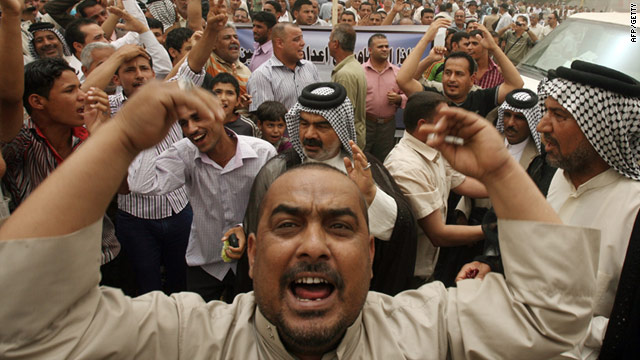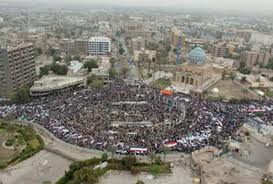The street that your question describes as “quiet” is actually silent only as a result of repression, especially after the protests of February 2011 when the authorities revealed their violence openly—using the army to clamp down on nonviolent protests and firing live ammunition at peaceful protestors.
— Falah Alwan, 22 January 2013, The Federation of Workers Councils and Unions in Iraq.
As the world marks ten years since the US invasion of Iraq, many will be thinking of that place again, perhaps for the first time in years. Discussions will be dominated by the use of the buzzword sectarianism to refer to and analyze any conflict and dynamic that exists in the country today. Most people wrongfully perceive sectarianism to be an inherent struggle indigenous to Iraq, and not as a political byproduct that serves the interests of a powerful few. It is important to understand that sectarianism in Iraq was exponentially magnified first by Saddam’s regime and regional actors, then even more so by the political ethno-sectarian quota system written into Iraq’s 2005 constitution by occupying forces.
Even those who can see through the smokescreen of sectarianism, and whose central concern is the people of Iraq—their daily lives, communities, and dreams—will likely only focus on the devastation and corruption that the last decade has brought: body counts, failed infrastructure, and how powers like the United States and Iran continue to dominate Iraq’s political scene.
For many different reasons, few discussions will focus on the political struggles waged by the Iraqi people themselves, and the victories that they can claim as their own. Struggles that are rooted in Iraq’s history of building movements that bring together different sects and ethnicities, and that take into account class differences, political affiliation, geography, gender, and generation, just to name a few. Through these struggles Iraqis will be able to transform their country from the bottom up.

Labor and Stopping the Oil Law
Unions in Iraq have been organizing for worker’s rights, as well as broader political freedoms — often explicitly opposed to US presence—from the moment the occupation began. The formation of dozens of independent groupings and federations speaks to the desire and vision of Iraq’s labor leaders, as well as the long legacy of its labor movement—which was severely undercut by Saddam’s repressive policies, cooptation, and war making.
January of 2008 saw a broad coalition of Iraqi labor organizations call for the ratification of a new labor law that would sanction the right to organize, bargain, and strike and undo the 1987 law banning all public sector unions, instituted by Saddam and upheld by Bremer’s Coalition Provisional Authority. Several public demonstrations accompanied this call.
In December of 2009 Federation of Workers Councils and Unions in Iraq, as well as associated unions in the leather industry, concluded a fifty-three-day strike (Iraq’s longest since 1931) after having gained much needed safety protections.
Perhaps the most resounding achievement of labor forces takes us back to September 2007. This was the deadline that the United States had set for Iraqi parliament to pass the “Oil Law” which was to institutionalize foreign corporate control over Iraq’s abundant hydro-carbon resources mainly through removing Iraqi oversight.
This law was blocked because labor groups deeply understood the risk this law posed to Iraqi sovereignty, and mobilized a popular campaign starting in December of 2006 to oppose the law, which eventually seeped into parliament and brought an end to the ratification process.
The struggle for Iraq’s resources and labor rights continues. Presently, active contracts with companies like Exxon exist without legal sanction, and the Iraqi parliament has yet to ratify a new labor law. The campaign for the right to organize, as well as to keep Iraq’s oil in Iraqi hands, sparked by the Iraqi Federation of Oil Unions around Basra, was a major blow to global and local interests, and a great source of pride and empowerment for many Iraqi activists.
Taking to al-Mutabanni and Other Streets
In response to the brutal occupation, its violence and the criminal levels of corruption it unleashed amongst local Iraqi politicians, Iraqis have also organized several large street demonstrations since 2003. Given the extreme lack of security, particularly between 2005 and 2009, these protests are remarkable to have existed at all.
On 25 February 2011, inspired by the uprisings across the Arab world, “The Iraqi Day of Rage,” a weekly Friday protest cycle, began in many of Iraq’s major cities. It was the rejuvenation of a protest movement that had been brutally suppressed by the Iraqi government. The demands were diverse, ranging from addressing chronically high unemployment and lack of services like electricity, to opposing the entire US-installed sectarian regime and occupation. Certain Fridays were themed around particular issues, with 18 March for example dubbed “Friday of the Imprisoned,” drawing attention to Iraq’s thousands of political prisoners and demanding their release.
Leaders, like the al-Zaidi brothers (Uday, Thurgham, and Muntazar–famed for throwing a shoe at George W. Bush) began to emerge, and other civil society leaders affiliated with labor and women’s groups got heavily involved. Several popular Iraqi protest Facebook pages appeared, and by 25 April, gatherings (which had taken the form of open-ended sit-ins) sometimes reached the tens of thousands. In the northern city of Mosul, protestors called a general strike, which froze all commerce and even pushed the local governor Atheel al-Nujaifi to back the protests and support the defiance of a government-imposed curfew.
The Shoe Thrower`s Brother from JOYCE! on Vimeo.
As the concrete results of the protests began to mount against Maliki’s regime (with many local politicians resigning, including two in Basra alone) protest squares became sites for politicized poetry and cultural performance, drawing on Iraq’s rich heritages.
The government responded with serious tactics of repression: firing tear gas as well as live ammunition, setting up checkpoint after checkpoint, forcing people to walk for hours in the scorching heat to what would otherwise be nearby squares. Security forces also banned all pens, markers, poster board, and water bottles.
Political consolidation within Iraq’s ruling elite enabled Nouri al-Maliki to absorb any dissenting local politicians such as in Basra. This also contributed to the severity of the crackdown, leading to a lull in this type of organizing. Many of these protest formations, and much of the energy that animated them, were to emerge in late 2012 when another protest wave began.
Iraq’s Women and Its Movements
Another of Iraq’s storied legacies is women’s leadership in the struggle for gender equality, social justice, and national sovereignty, which has continued throughout the last decade.
The occupation in Iraq has resulted in an alarming spike in domestic violence and the trafficking of women, strengthened by the reactionary Islamist leaders imposed by the US occupation. This has forced Iraqi women to act in emergency response to these harsh conditions, as well as structural gender inequality. Iraq’s women have also participated in various forms of public protest, including from within the labor movement.
Government repression against protesting women was most prominent in June of 2011 when Iraqi security and plainclothes thugs launched a coordinated attack on women in Baghdad’s Tahrir Square, tearing off their clothes and groping them. A leader from the Organization of Women’s Freedom in Iraq, who was part of the contingent on that day, explained: “It took us so many years to get women involved in the political struggle. And they went down to the Square to demand what they really want. And the prime minister decides to send these women home in what he knows is the best way, the most humiliating way. When the humiliation is sexual, in a society like Iraq, they know it will break the women.”

Where are the reporters?
These important and large-scale mobilization efforts have received little international media attention, even amongst Arabic language outlets. Uday al-Zaidi, echoing many Iraqi organizers, is quoted in late February of 2012 in Lebanese newspaper al-Akhbar saying:
We have sent our statements time and again to news networks such as Al-Jazeera, but they barely ever even call us,” said al-Zaidi. “In fact, you are the only non-Iraqi media who has called me today,” he said, on the first anniversary of the Iraqi “day of rage.”
Asked why he thought Iraq’s protesters did not make the news in the same way as other Arab uprisings, al-Zaidi said: “We do not follow the politics of any [foreign] state. Most of the international community has been complicit in crimes against the Iraqis. So it interests no network to really shed a light on us. That means we need to rely on ourselves, as individuals, to do our own media work.”
Beyond the Sectarian Frame and the Ongoing Demonstrations of 2013
In late December 2012, protestors took to the street to oppose a decision taken by Maliki’s government to imprison the bodyguards of Iraqi finance minister Rafi al-Issawi. Many perceived this to be motivated by sectarianism. Demonstrations ensued in the western province of al-Ramadi. People were not defending the Iraqi minister, whom they perceived to be another member of a corrupt government, but were objecting to sectarianism itself.
What began then as a seemingly limited public reaction to this decree quickly broke out of its mold to encompass many of the initial demands of the February 25 movement. These included the release of political prisoners, especially the thousands of women detained, more jobs and better services, and the removal of the Iraqi constitution. In particular, people were opposed to a “terrorism” law used often by the Iraqi government to target protestors with accusations of ties to al-Qaeda or the Saddam’s Ba’ath party.
By mid-January, the protests had spread to three other provinces in Iraq, al-Anbar, Niniweh, and Salah al-Deen. Media attention finally came to the protestors, but in the language of sectarianism that pigeon-holed the protests as driven by sectarian strife, without taking into account any of the social grievances that formed these large demonstrations. None of the media attention spoke of the explicit anti-sectarian slogans, nor of the important role of women in these movements.
The protests are now approaching their third straight month, and Falah Alwan’s late January analysis still rings true:
This moment could be a crossroads for more than one possibility—all is open now. First, it is possible that these protests could transform into a broad social revolution that changes the political system and builds another. And a new socio-political model could develop, one that opposes the model imposed on, and advertised for, in the region. The development of the present movement could refresh the revolution in the region as a whole and will not be apart from it—especially if it spreads through progressive forces to the Southern and Kurdish regions.
Another possibility is the continuing stubbornness of the government, its success in strengthening sectarianism, and the eventual deterioration to armed struggle and widespread unrest. This may be similar to what took place in Syria as well as in Iraq during 2006 and 2007, now with the lack of a US presence.
The regressive forces that risk losing their seats—should this movement grow—could push society in that direction. They could even attempt to divide the whole of Iraq officially.
The third possibility is that the protests remain concentrated in the West and North while the regime’s forces remain elsewhere. Then there might be a truce between some of the forces involved in the protests and the authorities, with a gradual shrinking of the movement.
All of these are possible. Though what has been realized now is that the regime is facing a broad mass of people who publicly reject its policies and boldly raise banners stating so. In other words, the people have intervened in a sphere that the authorities want to monopolize.
[This article was originally published on 14 March 2013 on shakomako, a digital magazine about everything Iraqi.]
![[Baghdad`s Tahrir Square, June 2011. From the Organization of Women`s Freedom in Iraq.]](https://kms.jadaliyya.com/Images/357x383xo/OWFI-June-2011.jpg)









